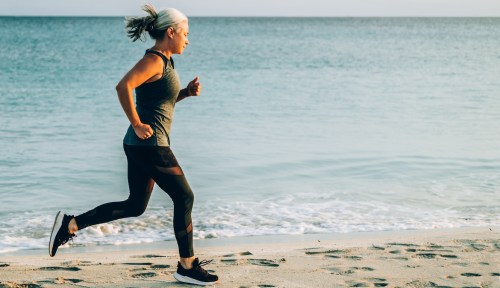Everything To Know About Running on Sand (Including Why It Feels So Much Harder)
Want to try running on the beach? Learn what running and exercise experts have to say about this fun but challenging twist on your daily runs.

There’s something idyllic about the idea of running on the beach: The sound of the waves crashing, the soft sand underfoot, the possibility of a post-run dip. There’s a reason why it’s the opening scene of Chariots of Fire, possibly the most iconic running movie ever made.
Experts in This Article
clinical associate professor of physical therapy at the University of Illinois, Chicago
exercise physiologist at the Hospital for Special Surgery
In reality, though, running on sand is hard. Funnily enough, that’s partially because it’s so soft: Sand absorbs far more force than a road, a track, or even a packed dirt trail, says Kate Baird, MA, ACSM-CEP, CSCS, an exercise physiologist at the Hospital for Special Surgery. This means you have to push off that much harder just to go the same distance on beach runs. Sand on the beach can also be slanted and/or uneven, adding a challenge to your balance and stability.
But that doesn’t mean running on the beach needs to stay a vacation fantasy. Use these expert tips for safe sandy runs.
How running on the beach challenges the body
Since you’ll be pushing off harder as you run on sand, all the muscles that typically tire during runs—the glutes, the hamstrings, the calves—will fatigue all the faster, says Baird. Having to stabilize on that soft, unpredictable surface also means that the intrinsic muscles on the bottoms of your feet are going to be working overtime, she says, especially if you’re going barefoot.
New York Road Runners group training coach Gordon Bakoulis says that the plantar fascia—the web of connective tissue covering the bottom of the foot—will also be challenged, so be especially cautious when approaching running on the sand if you’ve struggled with plantar fasciitis or any kind of foot injury.
You may find that your ankles are also having to work harder, especially if you’re running on uneven or slanted sand. Baird recommends trying to find the flattest part of the sand, at least to start.
The benefits of running on sand
While the biggest benefit to running on sand is likely that you’re probably running in a beautiful, relaxing place, there are perks for your body, too, like strengthening your feet and ankles, says Bakoulis, which can make you more resistant to injury over time. And one plus side of running on such a soft surface: You aren’t pounding on your joints as much as you would on roads or concrete, she says.
Also, running on sand can feel really good once you get the hang of it. Sweating it out alongside the ocean even offers uniquely restorative mental health benefits. And, as Baird points out, “the beach feels like a safer place than the jungle, or the forest.”
How to ease into running on sand
With the additional challenges on your muscles, it’s essential to start slow and short to avoid injury and extreme soreness, and to condition your body for the increased demands of running on sand.
Bakoulis says you should expect to run up to two minutes per mile slower as a similar effort on the road. But rather than looking at your watch or attempting road-to-sand conversions, just go by your perceived effort, she says: An easy run on the sand should feel as easy as an easy run on the road, which means it will inevitably be much slower. (And yes, unless you’re an experienced sand runner with access to a relatively flat stretch, your sand runs should probably be easy.)
Same goes for the length of your runs: Start with logging just a few miles at a time on the sand, suggests Bakoulis, and always cut down the length of any run you’d normally do on the road since “you get more bang for your buck” on the sand, she says.
And if you’re training for a long-distance race like a marathon, don’t try to log all your training miles on the sand during your vacation, warns Bakoulis. Try it one day for your easy run, or do one or two miles on the sand before transitioning onto the road or the treadmill for the rest of your run. (For what it’s worth, both Bakoulis and Baird give you permission to take a low-key taper week during your vacation.)
One running-on-the-beach logistical tip from Bakoulis: Since beach runs will inevitably be out-and-backs, be sure not to go out too far. “When you’re on the beach it just feels like, Oh, I could run forever,” she says, “and the next thing you know you’re four miles away from home and you’re exhausted and you don’t have any water, or a storm could come up out of nowhere.” If you’re planning on four miles, for instance, one strategy is to go one mile in one direction, come back, then go one mile in the other direction.
Even if it feels easy in the moment, don’t make the mistake of doing too much and hurting yourself. “A lot of times people feel like, if it feels easy, then my body must be tolerating it really well,” says Baird. “And that’s not always true—maybe the next day you wake up and you realize what you really asked of your body.”
How to approach your running form on the sand
Should running on sand change how you run? In general, Baird says no: Trying to change your running form usually isn’t a good idea, and since you’ll already be running on a new surface, adding another new element into the mix will only make the experience feel more unfamiliar to your body.
That said, a few simple cues can make running in the sand feel like less of a slog. For one, Baird says you’ll want to focus on taking shorter, faster steps, since long strides will be nearly impossible. And Bakoulis suggests making sure you’re remembering to lift your knees so that you aren’t shuffling through the sand—which is both inefficient and a tripping hazard. She also recommends widening your stance slightly for better stability if that feels comfortable.
To shoe or not to shoe?
There’s no one perfect answer to the question of whether or not to wear shoes when running on the beach. But there are some factors to consider. How hard and packed is the sand? If it’s on the stiffer side, stick with shoes, since the surface will be more similar to what you’re used to. If it’s soft, you may want to go barefoot to avoid your shoes filling up with hundreds of tiny little particles of sand. Also consider how familiar the area is, and if you can safely go barefoot without worrying about stepping on broken glass, or sharp shells. And if you have any foot conditions or injuries, opt for shoes, suggests Baird.
There are benefits to being barefoot. Baired points out that it feels nice; you can spread out your toes. Barefoot running also gives your feet and calves an extra workout, Aaron Keil, PT, previously told Well+Good. But since it’ll be a new challenge for your feet, work up to barefoot mileage cautiously. (Bakoulis suggests doing most of your run in shoes, then going barefoot for the last half mile and seeing how it feels.)
If you’re going with shoes, don’t wear any that you wouldn’t want to get wet and sandy. Trail shoes with waterproof features might be a good option if they aren’t too heavy or clunky, suggests Bakoulis. An older pair of your go-to trainers will work, too—just don’t wear anything with a high stack of cushion, which would only make you even more unstable.
More beach running tips to keep in mind:
Beat the heat: If you have the opportunity to run on the sand, that may mean you’re in a hot environment. Avoid running during the toastiest part of the day by going on early morning or late evening runs (which will also help you avoid the crowds), and don’t forget water and sunscreen.
Research the tides before you go: Look up high tide and low tide so you don’t end up having to turn your run into a swim.
Mind the slope: Know that a super sloped surface will probably slow you down even more. Try to balance yourself out by running equally in each direction (because one way your left foot will be higher, and the other way your right foot will be higher). Or, Bakoulis suggests running in a zig-zag up and down the beach to avoid the problem altogether.
Share the sand: If you’re running in the middle of the day, you may be darting around sandcastles, boogie boarders and fishermen. Be courteous and allow others to enjoy their sandy activity of choice.
Brace for soreness: Just like after any new activity, you’ll probably feel increased soreness after your first time running on sand, and possibly in places where running doesn’t typically make you sore, like the bottoms of your feet and your ankles. That’s normal, but take it as a sign not to do too much too soon, and pay attention to any sharp pain or extreme soreness.
“Make sure you’re doing a proper amount of warming up, stretching, and cooling down,” says Baird, “so that you don’t end up leaving your beach vacation feeling like you just ran a marathon, when all you did was run on the beach for three days.”










